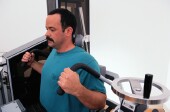
THURSDAY, Dec. 17 (HealthDay News) — While physicians and surgeons are getting better at treating heart attacks and other cardiovascular problems, too many Americans are ignoring the basic rules for preventing them, according to new statistics from the American Heart Association.
Topping the list: too little exercise, too much weight.
In fact, 59 percent of adults surveyed last year reported no activity vigorous enough to prompt sweating and a significant increase in breathing or heart rate, according to the update. The findings are published online Dec. 17 in the journal Circulation.
“The things people need to focus on are our weight and our waist,” said Dr. Donald M. Lloyd-Jones, chair of the heart association’s statistics committee. “Those are driving a lot of other risk factors, such as cholesterol and diabetes.”
Tackling inactivity and overweight will be key to turning heart health statistics around said Lloyd-Jones, who is also chairman of the department of preventive medicine and staff cardiologist at Northwestern University Feinberg School of Medicine.
The American diet also demands more attention, he said. “There is just too much availability of very calorie-dense food,” he said. “We’re not doing anything to burn off those extra pounds.”
Data from 2003-2006 shows that 11.3 percent of children and teenagers were at or above the 97th percentile in body mass index for their age. That’s ominous, because oerweight teens have a 70 percent chance of becoming overweight adults, the report notes.
Preventive measures should be emphasized for younger people, Lloyd-Jones said. “We need to be thinking about this as a life-long problem, not just when you turn 50,” he said.
Cholesterol control is ignored by many who would benefit from it most, according to the Heart Disease and Stroke Statistics 2010 update. Fewer than half the Americans with symptomatic heart disease are receiving treatment to lower their blood levels of fats, and only a third of people getting treatment are achieving the target levels of LDL cholesterol, the “bad kind” that clogs arteries.
“Everything is coming together in the worst way — obesity, inactivity, smoking,” said Dr. Clyde W. Yancy, heart association president and medical director of the Baylor Heart and Vascular Institute in Dallas. “In our younger group, instead of seeing improvement, it is getting worse.”
One relatively bright spot is better control of high blood pressure, a major cardiovascular risk factor, Lloyd-Jones said. “In the last few years, we have taken a bump up, and that gives us reason to hope, especially in prevention of heart failure,” he said.
Other findings:
- Death rates from cardiovascular disease declined about 30 percent between 1996 and 2006, as treatments improved.
- In 2006, 7.2 million in-hospital cardiovascular procedures were performed, a 33 percent increase over the 1996 level.
- The cost of treating cardiovascular disease is expected to rise 5.8 percent in 2010, to $503.2 billion, a figure that lends real urgency to prevention efforts, Lloyd-Jones said.
“So we are spending half a trillion dollars on cardiovascular disease,” Yancy said. “And we recognize that, as in our younger population the incidence of sedentary life style, obesity and smoking are going up, that expenditure will continue to rise.”
By 2020, the association hopes for a 20 percent improvement in the cardiovascular health of all Americans and a 20 percent reduction in deaths from cardiovascular diseases and stroke.
More information
Cardiovascular risk factors are listed by the American Heart Association.

